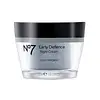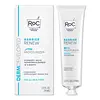What's inside
What's inside
 Key Ingredients
Key Ingredients

 Benefits
Benefits

 Concerns
Concerns

 Ingredients Side-by-side
Ingredients Side-by-side

Water
Skin ConditioningGlycerin
HumectantSorbitan Stearate
EmulsifyingDimethicone
EmollientCaprylic/Capric Triglyceride
MaskingEthylhexyl Stearate
EmollientButyrospermum Parkii Butter
Skin ConditioningCetearyl Alcohol
EmollientPolyacrylamide
Phenoxyethanol
PreservativeAlcohol Denat.
AntimicrobialC13-14 Isoparaffin
EmollientDimethiconol
EmollientParfum
MaskingButylene Glycol
HumectantSucrose Cocoate
EmulsifyingMethylparaben
PreservativeCarbomer
Emulsion StabilisingPropylene Glycol
HumectantTocopheryl Acetate
AntioxidantEthylparaben
PreservativeAscorbyl Glucoside
AntioxidantLaureth-7
EmulsifyingRetinyl Palmitate
Skin ConditioningXanthan Gum
EmulsifyingHydrolyzed Rice Protein
Skin ConditioningTetrasodium EDTA
Potassium Hydroxide
BufferingPanax Ginseng Root Extract
EmollientDimethylmethoxy Chromanol
AntioxidantMedicago Sativa Extract
TonicPolysorbate 20
EmulsifyingMorus Alba Leaf Extract
Skin ConditioningIsopropyl Myristate
EmollientSodium Benzoate
MaskingTocopherol
AntioxidantEthylhexylglycerin
Skin ConditioningPalmitoyl Tripeptide-1
Skin ConditioningPalmitoyl Tetrapeptide-7
Skin ConditioningWater, Glycerin, Sorbitan Stearate, Dimethicone, Caprylic/Capric Triglyceride, Ethylhexyl Stearate, Butyrospermum Parkii Butter, Cetearyl Alcohol, Polyacrylamide, Phenoxyethanol, Alcohol Denat., C13-14 Isoparaffin, Dimethiconol, Parfum, Butylene Glycol, Sucrose Cocoate, Methylparaben, Carbomer, Propylene Glycol, Tocopheryl Acetate, Ethylparaben, Ascorbyl Glucoside, Laureth-7, Retinyl Palmitate, Xanthan Gum, Hydrolyzed Rice Protein, Tetrasodium EDTA, Potassium Hydroxide, Panax Ginseng Root Extract, Dimethylmethoxy Chromanol, Medicago Sativa Extract, Polysorbate 20, Morus Alba Leaf Extract, Isopropyl Myristate, Sodium Benzoate, Tocopherol, Ethylhexylglycerin, Palmitoyl Tripeptide-1, Palmitoyl Tetrapeptide-7
Water
Skin ConditioningCaprylic/Capric Triglyceride
MaskingSqualane
EmollientDimethicone
EmollientButylene Glycol
HumectantMethyl Trimethicone
Skin ConditioningGlycerin
HumectantBeta-Sitosterol
Emulsion StabilisingCeramide NP
Skin ConditioningCeramide Ng
Skin ConditioningPalmitoyl Tripeptide-8
Skin ConditioningCamellia Sinensis Leaf Extract
AntimicrobialButyrospermum Parkii Butter
Skin ConditioningEuphorbia Cerifera Wax
Tocopherol
AntioxidantGlyceryl Behenate
EmollientLecithin
EmollientPolyacrylamide
Polysilicone-11
Polyglyceryl-4 Isostearate
EmulsifyingDextran
Oleic Acid
EmollientSodium Acrylates Copolymer
C13-14 Isoparaffin
EmollientAmmonium Acryloyldimethyltaurate/Vp Copolymer
Laureth-7
EmulsifyingPhenoxyethanol
PreservativeEthylhexylglycerin
Skin ConditioningWater, Caprylic/Capric Triglyceride, Squalane, Dimethicone, Butylene Glycol, Methyl Trimethicone, Glycerin, Beta-Sitosterol, Ceramide NP, Ceramide Ng, Palmitoyl Tripeptide-8, Camellia Sinensis Leaf Extract, Butyrospermum Parkii Butter, Euphorbia Cerifera Wax, Tocopherol, Glyceryl Behenate, Lecithin, Polyacrylamide, Polysilicone-11, Polyglyceryl-4 Isostearate, Dextran, Oleic Acid, Sodium Acrylates Copolymer, C13-14 Isoparaffin, Ammonium Acryloyldimethyltaurate/Vp Copolymer, Laureth-7, Phenoxyethanol, Ethylhexylglycerin
 Reviews
Reviews

Ingredients Explained
These ingredients are found in both products.
Ingredients higher up in an ingredient list are typically present in a larger amount.
Butylene Glycol (or BG) is used within cosmetic products for a few different reasons:
Overall, Butylene Glycol is a safe and well-rounded ingredient that works well with other ingredients.
Though this ingredient works well with most skin types, some people with sensitive skin may experience a reaction such as allergic rashes, closed comedones, or itchiness.
Learn more about Butylene GlycolThis ingredient is also known as shea butter. It is an effective skin hydrator and emollient.
Emollients help soothe and soften your skin. It does this by creating a protective film on your skin. This barrier helps trap moisture and keeps your skin hydrated. Emollients may be effective at treating dry or itchy skin.
Shea butter is rich in antioxidants. Antioxidants help fight free-radicals, or molecules that may harm the body. It is also full of fatty acids including stearic acid and linoleic acid. These acids help replenish the skin and keep skin moisturized.
While Shea Butter has an SPF rating of about 3-4, it is not a sunscreen replacement.
Shea butter may not be fungal acne safe. We recommend speaking with a professional if you have any concerns.
Learn more about Butyrospermum Parkii ButterThis ingredient is also known as "C13-14 Isoalkane".
C13-14 Isoparaffin is created from petroleum-based mineral oils. It is an emollient and helps thicken a product.
As an emollient, it helps keep the skin soft and smooth by creating a barrier on top. This barrier traps moisture in, keeping the skin hydrated.
C13-14 Isoparaffin may not be fungal-acne safe.
Learn more about C13-14 IsoparaffinThis ingredient is an emollient, solvent, and texture enhancer. It is considered a skin-softener by helping the skin prevent moisture loss.
It helps thicken a product's formula and makes it easier to spread by dissolving clumping compounds.
Caprylic Triglyceride is made by combining glycerin with coconut oil, forming a clear liquid.
While there is an assumption Caprylic Triglyceride can clog pores due to it being derived from coconut oil, there is no research supporting this.
Learn more about Caprylic/Capric TriglycerideDimethicone is a type of synthetic silicone created from natural materials such as quartz.
What it does:
Dimethicone comes in different viscosities:
Depending on the viscosity, dimethicone has different properties.
Ingredients lists don't always show which type is used, so we recommend reaching out to the brand if you have questions about the viscosity.
This ingredient is unlikely to cause irritation because it does not get absorbed into skin. However, people with silicone allergies should be careful about using this ingredient.
Note: Dimethicone may contribute to pilling. This is because it is not oil or water soluble, so pilling may occur when layered with products. When mixed with heavy oils in a formula, the outcome is also quite greasy.
Learn more about DimethiconeEthylhexylglycerin (we can't pronounce this either) is commonly used as a preservative and skin softener. It is derived from glyceryl.
You might see Ethylhexylglycerin often paired with other preservatives such as phenoxyethanol. Ethylhexylglycerin has been found to increase the effectiveness of these other preservatives.
Glycerin is already naturally found in your skin. It helps moisturize and protect your skin.
A study from 2016 found glycerin to be more effective as a humectant than AHAs and hyaluronic acid.
As a humectant, it helps the skin stay hydrated by pulling moisture to your skin. The low molecular weight of glycerin allows it to pull moisture into the deeper layers of your skin.
Hydrated skin improves your skin barrier; Your skin barrier helps protect against irritants and bacteria.
Glycerin has also been found to have antimicrobial and antiviral properties. Due to these properties, glycerin is often used in wound and burn treatments.
In cosmetics, glycerin is usually derived from plants such as soybean or palm. However, it can also be sourced from animals, such as tallow or animal fat.
This ingredient is organic, colorless, odorless, and non-toxic.
Glycerin is the name for this ingredient in American English. British English uses Glycerol/Glycerine.
Learn more about GlycerinLaureth-7 is created by the ethoxylation of lauryl alcohol using ethylene oxide. Lauryl alcohol is a fatty alcohol with hydrating properties.
This ingredient is an emulsifier and cleansing ingredient. As an emulsifier, it is used to prevent ingredients from separating. It also helps cleanse the skin by gathering dirt, oil, and pollutants to be rinsed away.
Phenoxyethanol is a preservative that has germicide, antimicrobial, and aromatic properties. Studies show that phenoxyethanol can prevent microbial growth. By itself, it has a scent that is similar to that of a rose.
It's often used in formulations along with Caprylyl Glycol to preserve the shelf life of products.
Polyacrylamide is a synthetic polymer. It is used to stabilize products and bind ingredients. When hydrated, Polyacrylamide forms a soft gel.
Polyacrylamide is low-toxicity. If source properly, it is deemed safe to use in cosmetics.
It should be noted the precursor to Polyacrylamide is acrylamide. Acrylamide is a carcinogen. Most reputable sources of Polyacrylamide will screen for residual acrylamide to make sure the count is in a safe range. Acrylamide is not able to be absorbed through the skin.
We recommend speaking with a professional if you have concerns.
Learn more about PolyacrylamideTocopherol (also known as Vitamin E) is a common antioxidant used to help protect the skin from free-radicals and strengthen the skin barrier. It's also fat soluble - this means our skin is great at absorbing it.
Vitamin E also helps keep your natural skin lipids healthy. Your lipid skin barrier naturally consists of lipids, ceramides, and fatty acids. Vitamin E offers extra protection for your skin’s lipid barrier, keeping your skin healthy and nourished.
Another benefit is a bit of UV protection. Vitamin E helps reduce the damage caused by UVB rays. (It should not replace your sunscreen). Combining it with Vitamin C can decrease sunburned cells and hyperpigmentation after UV exposure.
You might have noticed Vitamin E + C often paired together. This is because it is great at stabilizing Vitamin C. Using the two together helps increase the effectiveness of both ingredients.
There are often claims that Vitamin E can reduce/prevent scarring, but these claims haven't been confirmed by scientific research.
Learn more about TocopherolWater. It's the most common cosmetic ingredient of all. You'll usually see it at the top of ingredient lists, meaning that it makes up the largest part of the product.
So why is it so popular? Water most often acts as a solvent - this means that it helps dissolve other ingredients into the formulation.
You'll also recognize water as that liquid we all need to stay alive. If you see this, drink a glass of water. Stay hydrated!
Learn more about Water